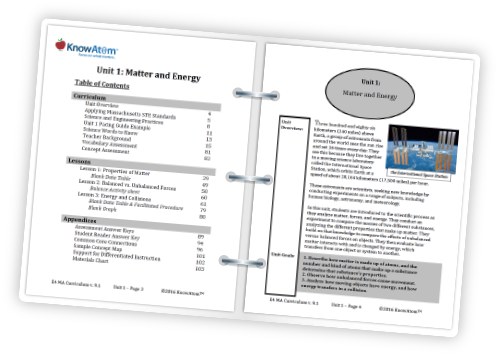In 4th grade, students develop experiments to answer questions and build prototypes to solve problems related to real-world phenomena. Each month-long unit gives students the opportunity to develop ideas and build on concepts integrated across different disciplines over time.

Unit 1
Unit 2
Unit 3
Unit 4
Unit 5
Unit 6
Unit 7
Unit 8
Unit 9
In Unit 1 Matter and Energy, students explore how scientists on the International Space Station carry out experiments to look for patterns and cause-and-effect relationships in the world around them.

In Unit 2 Shaping Earth’s Surface, students investigate how Earth’s systems and natural processes have shaped the Grand Canyon and Earth’s surface over time.
Grade-Specific Standards : 4-ESS1-1, 4-ESS2-1, 4-ESS2-2, 4-ESS3-1

In Unit 3 Earth and Human Activity, students explore how Earth’s hydrosphere, geosphere, and biosphere interact by investigating the phenomena of aquifer formation, urban flooding, and hydroelectric dams capturing energy in moving water.
Grade Specific Standards: 4-ESS1-1, 4-ESS3-2, 4.3-5-ETS1-3, 4.3-5-ETS1-5 (MA)
Supporting Standards: 3-ESS2-1, 3-ESS2-2, 3-ESS3-1, 5-ESS2-1, 5-ESS2-2, 5-ESS3-1, 3.3-5-ETS1-1, 3.3-5-ETS1-2, 3.3-5-ETS1-4 (MA), 5-ESS3-2 (MA)

In Unit 4 Plant and Animal Structures, students explore how living things depend on their environment and one another for survival.
Grade-Specific Standard : 4-LS1-1
Supporting Standards : 3-LS1-1, 5-LS1-1, 5-LS2-1, 5-PS3-1, 3-LS4-5(MA)

In Unit 5 Organisms and Their Environment, students investigate how animals process information from the environment with sensory structures and how that information influences behaviors.

In Unit 6 Energy Transfers, students investigate how simple machines make life easier and how levers can be used to launch projectiles by exploring the relationship between forces, energy, and motion.
Grade-Specific Standards : 4-PS3-2, 4-PS3-4, 4.3-5-ETS1-3, 4.3-5-ETS1-5 (MA)
Supporting Standards : 3-PS2-1, 5-PS2-1, 3.3-5-ETS1-1, 3.3-5-ETS1-2, 3.3-5-ETS1-4 (MA), 5-ETS3-1 (MA), 5-ETS3-2 (MA)

In Unit 7 Electrical Energy, students explore how devices such as flashlights and electric car motors function by investigating how energy is transferred in circuits and can do work.
Grade-Specific Standards : 4-PS3-2, 4-PS3-4, 4.3-5-ETS1-3, 4.3-5-ETS1-5 (MA)
Supporting Standards : 5-PS1-3, 3.3-5-ETS1-1, 3.3-5-ETS1-2, 3.3-5-ETS1-4 (MA), 5-ETS3-1 (MA), 5-ETS3-2 (MA)

In Unit 8 Sound Waves, students investigate how whales communicate over long distances by exploring how sound energy is transferred in waves of vibrating molecules.

In Unit 9 Light and Communication, students explore how different technologies use patterns of sound, light, or numbers to transfer information from one place to another.
Grade-Specific Standards : 4-PS3-2, 4-PS3-4, 4-PS4-2, 4-PS4-3, 4.3-5-ETS1-3, 4.3-5-ETS1-5 (MA)
Supporting Standards : 5-PS1-3, 4-PS3-4, 4-PS4-2, 4-PS4-3, 3.3-5-ETS1-1, 3.3-5-ETS1-2, 3.3-5-ETS1-4 (MA), 5-ETS3-1 (MA), 5-ETS3-2 (MA)
